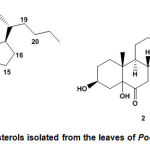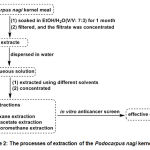Yuchen Xiao1,3,4, Jianping Yong2*, Yang Yang1 and Canzhong Lu1,2,4
1Fujian Institute of Research on the Structure of Matter, Haixi Institute, Chinese Academy of Sciences, China.
2Xiamen Institute of Rare-earth Materials, Haixi Institute, Chinese Academy of Sciences, China.
3Shanghai Tech University, China.
4University of Chinese Academy of Sciences, China.
Corresponding Authors, E-mail: jpyong@fjirsm.ac.cn
DOI : https://dx.doi.org/10.13005/bpj/2134
Abstract
Cancer is a major public health problem worldwide, and it is one of the top three major diseases in terms of mortality. Some small molecular synthesized drugs have been used clinically. However, much side-effects were also appeared during treatment of the cancer patients with the synthesized anticancer drugs in clinical. Some Chinese Traditional Plant Medicines have ever been used for treatment of cancer with the low side-effects. Thus, it is essential to find anticancer drugs or drug candidates from Chinese Traditional Plant Medicines. Podocarpus nagicontains different kinds of biological components together with a wide spectrum of biological activities, and it has ever been used in the folk of Yao Nationality for treatment different diseases. It is essential to study this folk plant medicine to discover new drugs or drug candidates. In this work, we obtained different polar extractions and evaluated their in vitro anticancer activity.
Keywords
Anticancer evaluation; Different Polar Extractions; Podocarpus Nagikernel Meal
Download this article as:| Copy the following to cite this article: Xiao Y, Yong J, Yang Y, Lu C. The Ethyl Acetate Extraction Obtained from Podocarpus Nagikernel Meal with Anticancer Activity. Biomed Pharmacol J 2021;14(1). |
| Copy the following to cite this URL: Xiao Y, Yong J, Yang Y, Lu C. The Ethyl Acetate Extraction Obtained from Podocarpus Nagikernel Meal with Anticancer Activity. Biomed Pharmacol J 2021;14(1). Available from: https://bit.ly/3uZHiw3 |
Introduction
Cancer is a major public health problem worldwide. According to estimates from the World Health Organization (WHO) in 2015, cancer is the first or second leading cause of death before age 70 years in 91 of 172 countries, and it ranks the third or fourth in an additional 22 countries[1].
It is estimated that about 1,806,590 new cancer cases will be diagnosed in the United States in 2020 and 606,520 cancer deaths are projected to occur[2]. There is a report from the World Health Organization that cancer caused 8.8 million deaths in 2015. The most common type of cancer was lung cancer (1.69 million deaths), liver cancer (788,000 deaths), colorectal cancer (774,000), stomach cancer (754,000 deaths) and breast cancer (571,000 deaths). Cancer has caused a great threat to human survival. Even if some new drugs have been used in clinical for treatment of cancer, however, the higher price and side effects of cancer drugs lead to find more new drugs with higher activity, low side effects and low cost for the patients. Especially, the new drugs discovered from the Chinese Traditional Plant Medicines have become the main stream of drug development.
Podocarpus nagi (P. nagi, named Zhubai in Chinese) is widely distributed in south districts of Yangtze River, such as Fujian, Hunan, Guangxi and Guangdong, etc.. This plant contains different kinds of biological components (such as volatile oil, flavonoids, steroids, sugar and glycosides, lactones, etc.) and it exhibits a wide spectrum of biological activities: such as hemostasis, bone setting, anti-bacterial, anti-tumor, antiviral, antioxidant and detumescence activities [3]. The essential oil of P. nagi meal has been reported to exhibit antitumor activity [4]. According to the folk records of the Yao Nationality, P. nagi has ever been used to treat trauma, stop-bleeding, fractures, knife wounds, gunshot wounds, body odor, eye diseases and colds, etc. The fresh bark or root of P. nagi was also used to treat the rheumatoid arthritis [5-6].
During our previous work, our research group also isolated two new sterols from the leaves of P. nagi: 26,27-dinorcholest-5-en-3-β-ol(1) and (24R)-3β,5α-dihydroxy-24-ethyl -5α-cholestan-6-one(2)(Figure 1) and compound 1 exhibited higher anticancer activity against gastric cancer, breast cancer (MCF-7), lung cancer(A549) and Hela cell lines[7]. In addition, our research group also prepared the edible oil from the P. ngai kernel and this oil exhibited higher antioxidant and anticancer activity [8]. In order to find the active new components with anticancer activity from this plant medicine, we studied the P. ngai kernel meal(which is the residue after extracting the oil from the P. ngai kernel) in current work. We mainly extracted different polar extractions and tested their in vitro anticancer activity to select the active extraction to provide the scientific guidance for the below work. The experimental procedure listed in figure 2.
 |
Figure 1: New sterols isolated from the leaves of Podocarpus nagi. |
 |
Figure 2: The processes of extraction of the Podocarpus nagi kernel meal. |
Experiment
Materials and instruments
The P. nagi kernel meal (which is the residue after extracting the oil from the P. ngai kernel) was collected in September of 2018 from the Yangli town of Fujian province and powdered; other chemicals used for chemical extractions and biological evaluations are analytical reagents and commercially available.
Full-wavelength multifunctional microplate reader (Multiskan GO, USA).
Detailed processes of extraction
15 kg powdered P. nagi kernel meal was soaked in a solution of Vethanol/Vwater=7:3 (20L) for 30 days at room temperature. Then, it was filtered and the filtrate was concentrated under reduced pressure to obtain extract 800 g, which was dispersed in 1000mL water and extracted with n-hexane, ethyl acetate and dichloromethane (3×1000mL) respectively. The organic layers were concentrated under reduced pressure to obtain three different polar extractions, which were dried in vacuum drying oven at 60oC for 1 hour to obtain the samples for biological screen.
Preliminary in vitro anticancer evaluation
The anticancer activity of obtained extractions(n-hexane extraction, ethyl acetate extraction and dichloromethane extraction)was evaluated against gastric cancer, breast cancer (MCF-7), lung cancer(A549) and Hela cell lines using the counting kit-8 (CCK-8) method[9]. The evaluation processes were described elsewhere with some modifications. Briefly, the three extractions (n-hexane extraction, ethyl acetate extraction and dichloromethane extraction)were dissolved in DMSO at a starting concentration of 6.5mg/mL, 16.9mg/mL and 7.8mg/mL, respectively for below using.
The procedure for anticancer evaluation
The target cancer cell lines were seeded in 96-well plates (5000cells/well) with 100μL DMEM supplemented with 10% fetal bovine serum, and cultured at 37 oC in a humidified CO2 incubator (95% air, 5% CO2) for 24h. While the cell lines grew to 90% in logarithmic growth, the culture medium was removed from each well, and 100μL fresh DEME was added to each well. Then, 10μL above prepared solutions of different extractionswere added into each well (every concentration was repeated for 5 times) and the plates were incubated for another 48h at 37 oC. Subsequently, 10μL CCK8 was added to each well, and the plates were cultured at 37 oC for another 4 hours. The optical density was measured at a wave-length of 450 nm on an ELISA microplate reader. DMEM and DMSO solution (V/V: 10/1) was used as a negative control. The results were expressed as the inhibition calculated at the ratio {[1-(OD450 treated/ OD450 negative control)] ×100}. By comparing the anticancer efficacy of three different extractions, ethyl acetate extract exhibited higher anticancer efficacy against gastric cancer, breast cancer (MCF-7), lung cancer(A549) and Hela cell lines. The results showed in table 1.
Table 1: The inhibition rate of ethyl acetate extract to four tumor cell lines at 16.9mg/mL
| Concentration
(mg/mL) |
Inhibition (%)±SD (n=5) | |||
| Gastric cancer | Breast cancer (MCF-7) | Lung cancer (A549) | Hela | |
| 16.9 | 97.04±0.52 | 51.72±1.06 | 96.61±1.26 | 50.52±1.85 |
Conclusion
In this work, we obtained three different polar extractions from the P. nagi kernel meal and evaluated their anticancer efficacy against gastric cancer, breast cancer (MCF-7), lung cancer(A549) and Hela cell lines. The results showed that the ethyl acetate extraction exhibited higher anticancer activity against four listed cancer cell lines, which provided the scientific guidance for the subsequent work. Now we will focus on isolation and anticancer evaluation of this extraction for studying its material basis.
Acknowledgements
This work was financially supported by the National Natural Science Foundation of China (21875252) and Self-created Area Project of Major Science Technology Innovation Platform of Xiamen (3502ZCQ20171002).
References
- Bray F, Ferlay J. Global Cancer Statistics 2018: GLOBOCAN Estimatesof Incidence and Mortality Worldwide for 36 Cancersin 185 Countries; CA Cancer J. Clin. 68: 394-424(2018).
CrossRef - Rebecca L, Kimberly D. Cancer Statistics; CA Cancer J. Clin.0: 1-24 (2020).
- YangY, YongJP, Lu CZ. Chemical and biological progress of Podocarpus nagi. Biomedical Research and Reviews; 2:1-5(2019).
CrossRef - Li SP. Side effects of anticancer and chemotherapy drugs. Chinese Journal of Rural Medicine and Pharmacy 12: 24-26(1996).
- State Administration of Traditional Chinese Medicine Editorial Board of <Zhong Hua Ben Cao >. Zhong Hua Ben Cao. Shanghai Scientific & Technical Publishers, China. p.813(1999).
- Chinese modern Yao medicine, Nanning: Guangxi science and Technology Publishers, China; p.257(2009).
- YangY, YongJP, Olagoke, ZO, LuCZ. First Isolation and Confirmation of Sterol Based on β-sitosterol Skeleton from the Leaves of Podocarpus nagi Planted in Fujian, Preliminary in vitro Anticancer Activity and the Crystal Structure. Chinese Journal of Structure Chemistry. DOI: 10.14102/j.cnki.0254–5861.2011–2981
- YongJP,LuCZ, ZhangSB. Preparation method and use of Podocarpus Nagi kernel oil. AU innovation patent. 2020100726(2020)
- TominagaH, IshiyamaM, OhsetoF, Sasamoto K, HamamotoT, SuzukiK, WatanabeM. A water-soluble tetrazolium salt useful for colorimetric cell viability assay. Analytical Communications: 36, 47-50(1999).
CrossRef








